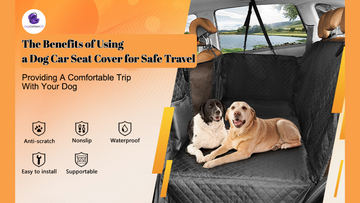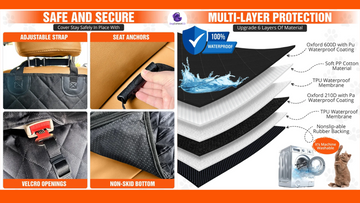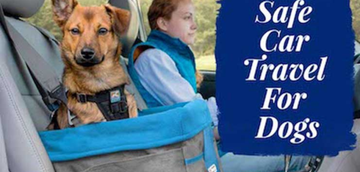Is Your Dog Safe Enough in the Car? Simple Safety Checklist for Every Trip
by Rizwan Saqib on Jun 25, 2025
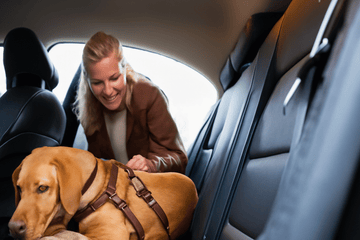
Introduction:
When was the last time you really thought about your dog’s safety during car rides? Many pet owners secure their human passengers with seatbelts without a second thought, but leave their four-legged family members completely unrestrained. According to research, while 83% of drivers acknowledge the dangers of unrestrained pets in vehicles, only 16% actually use proper restraints. This disconnect puts both pets and humans at serious risk every time they hit the road.
A 60-pound dog traveling at just 35 mph can become a 2,700-pound projectile force during a collision. That’s not just dangerous for your pet—it’s potentially deadly for everyone in the vehicle. This article provides a comprehensive safety checklist and practical tips to ensure your dog stays safe during every car journey, whether it’s a quick trip to the vet or a cross-country adventure.
Understanding the Risks of Unrestrained Dogs in Vehicles
The dangers of traveling with an unrestrained dog extend far beyond the obvious risk of your pet being injured during an accident. Unrestrained dogs create multiple types of distractions for drivers:

- Visual distractions: Taking your eyes off the road to check on your pet
- Manual distractions: Reaching to pet, feed, or control your dog
- Cognitive distractions: Worrying about what your dog is doing instead of focusing on driving
Research shows that drivers who always travel with pets have significantly higher collision rates (relative risk of 1.89) compared to those who don’t. This isn’t surprising when you consider how easily an excited or anxious dog can disrupt a driver’s concentration.
Beyond accident risks, unrestrained dogs can also:
- Jump out of open windows
- Escape when the doors are opened
- Interfere with vehicle controls
- Block the driver’s view
- Become trapped under pedals
“Having your dog in a car without proper restraint can be dangerous for both the pet and human passengers,” explains Dr. Melissa Bain, a veterinary behaviorist at UC Davis. “Even the most well-behaved dog can become a hazard during sudden stops or turns.”
Essential Dog Car Safety Products for Every Pet Owner
A properly fitted dog car safety harness is essential for protecting your pet during sudden stops or accidents. When shopping for a dog car safety harness, look for one that has been crash-tested and certified by the Centre for Pet Safety (CPS), an independent non-profit organisation that tests pet safety products.
The best dog car safety harness options include the Sleepypod Clickit Sport, which has passed rigorous crash tests. Other CPS-certified options include:
- Sleepypod Clickit Terrain
- Sleepypod Clickit Range
- Ruffwear Load Up (performed well in testing)
For smaller dogs, a dedicated dog car seat elevates them so they can see out the window while staying safely restrained. When installing a dog car seat, always follow the manufacturer’s instructions for proper attachment to the vehicle.
Other essential dog car safety products include:
- Travel carriers and crates: Must be secured to the vehicle to prevent movement
- Vehicle pet barriers: Keep dogs in the back seat or cargo area
- Seat belt attachments: Work with your dog’s regular harness (not collar)
- Travel water bowls: Prevent dehydration on longer trips
- Window shades: Protect from the sun and heat
Investing in quality dog car safety products can prevent distracted driving and protect your pet in case of an accident. The market for dog car safety products has grown as more pet owners recognize the importance of proper restraint.
Best Practices for Safe Car Travel with Your Dog
Finding the best dog car safety harness for your pet depends on their size, weight, and activity level during travel. Reviews can help you identify the best dog car safety harness for your specific breed and travel needs.
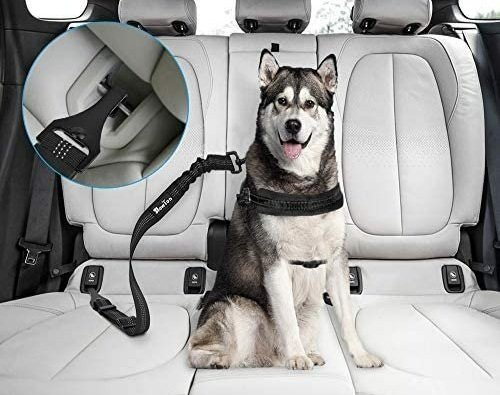
Pre-Travel Preparation
One of the most important dog car safety tips is to gradually acclimate your pet to car travel before long journeys. Start with short trips to positive destinations (not just the vet) to help your dog form positive associations with car travel.
“Keeping your dog in car safely requires proper restraint and temperature management,” advises veterinarian Dr. Sarah Wilson. “Many dogs experience anxiety or motion sickness during car rides, which can be managed with proper training and, if necessary, consultation with your veterinarian.”
Update your dog’s microchip information before any major trip, and research emergency vet locations along your route. Pack a pet-specific first aid kit that includes:
- Gauze pads and bandages
- Antiseptic wipes
- Tweezers for splinter or tick removal
- Digital thermometer
- Blunt-end scissors
- Saline eye wash
- Your dog’s medications
- Vet contact information
During Travel Safety Protocols
Following these dog car safety tips can help ensure a pleasant and secure journey for everyone:
- Secure your dog before starting the engine: This prevents them from interfering while you’re getting settled.
- Never allow your dog to ride in the front seat: Airbags can be deadly to pets during deployment.
- Take regular breaks: Stop every 2-3 hours to allow your dog to stretch, relieve themselves, and drink water.
- Maintain appropriate temperature: Never leave your dog in car unattended, especially during warm weather when temperatures can rise quickly. Even on a 70°F day, car interiors can reach 104°F within 30 minutes.
- Keep heads inside: Though dogs love feeling the wind in their fur, allowing them to stick their heads out windows can lead to eye injuries from debris or worse.
Professional trainers offer valuable dog car safety tips for pets who experience anxiety during travel. Techniques such as positive reinforcement, anxiety wraps, or calming pheromones can help make the experience less stressful for nervous dogs.
Legal Requirements for Dog Car Travel
Many pet owners are surprised to learn that several states have specific laws regarding dogs in vehicles. Understanding these regulations can help you avoid fines and ensure compliance during interstate travel.
States with Explicit Restraint Laws:
- New Jersey: Requires pets to be properly secured in a carrier or with a harness/seat belt. Violations can result in fines of $250-$1,000.
- Rhode Island: Mandates physical control or restraint of animals in vehicles. Fines can reach $200.
- Hawaii: Prohibits drivers from holding pets on their laps. Fines include $97 for lap holding and $57 for unrestrained pets.
Even in states without specific pet restraint laws, drivers can be cited for distracted driving if an unrestrained pet interferes with vehicle operation. Additionally, some insurance companies may deny claims if an accident was caused by an unrestrained pet, considering it negligence.
“The legal landscape for pet travel is evolving,” explains animal law attorney Jennifer Reba Edwards. “More states are considering legislation as awareness grows about the dangers of unrestrained pets in vehicles.”
The Ultimate Dog Car Safety Checklist
Use this comprehensive checklist before every trip with your dog to ensure maximum safety:
Before Your Trip:
- Ensure your dog’s ID tags are current
- Update microchip information if needed
- Pack sufficient food, water, and medications
- Prepare a pet first-aid kit
- Research emergency vet locations along your route
- Check that your dog’s restraint system fits properly
- Clean and inspect safety equipment for wear or damage
- Plan your route with pet-friendly stops
Vehicle Preparation:
- Secure crate/carrier to vehicle using straps or other anchoring methods
- Install barriers properly if using them
- Remove hazardous items from your dog’s reach
- Protect upholstery with seat covers if desired
- Ensure proper ventilation
- Pack window shades for temperature management
- Secure all luggage to prevent shifting onto your dog
During Travel:
- Never leave your dog alone in the vehicle
- Monitor for signs of anxiety, motion sickness, or distress
- Maintain comfortable temperature (68-76°F is ideal)
- Offer water during breaks (never while moving)
- Allow bathroom breaks every 2-3 hours
- Keep your dog’s leash on during stops before opening doors
- Recheck restraint systems after breaks
This checklist addresses both safety and comfort concerns, helping ensure a positive experience for both you and your dog during car travel.
Common Misconceptions About Dog Car Safety
Several myths persist about traveling with dogs in cars. Let’s address some of the most common misconceptions:
Myth 1: My dog is well-behaved and doesn’t need restraint.
Even the most obedient dog can become a projectile during sudden stops or accidents. Restraint is about physics, not behavior.
Myth 2: Holding my small dog is safer than using a restraint.
This is dangerous for both you and your pet. During a collision, you cannot safely hold onto your dog, and your pet becomes caught between you and the airbag or dashboard.
Myth 3: My dog prefers to be unrestrained and gets anxious when secured.
While some dogs may initially resist restraints, most can be trained to accept them with patience and positive reinforcement. The temporary discomfort of acclimation is far outweighed by the safety benefits.
Myth 4: A barrier between the back seat and front seat is sufficient protection.
While barriers prevent dogs from moving between areas of the vehicle, they don’t protect your pet during a collision. Proper harnesses or secured carriers are still necessary.
Myth 5: Any harness marketed for cars is crash-tested and safe.
Unfortunately, many products marketed as “car safe” have not undergone rigorous testing. Always look specifically for CPS certification or crash-test verification.
Conclusion: Making Every Trip Safer for Your Dog
The statistics are clear: most pet owners understand the risks of unrestrained dogs in vehicles but don’t take action to address them. By implementing the safety measures outlined in this article, you’re not just protecting your dog—you’re making the road safer for everyone.
Remember that proper restraint is just the beginning. Temperature management, regular breaks, and emergency preparedness all contribute to a comprehensive safety strategy for traveling with your dog.
Start with one simple step: invest in a properly fitted, crash-tested dog car safety harness or carrier. From there, gradually implement the other recommendations until safe travel becomes second nature for both you and your pet.


